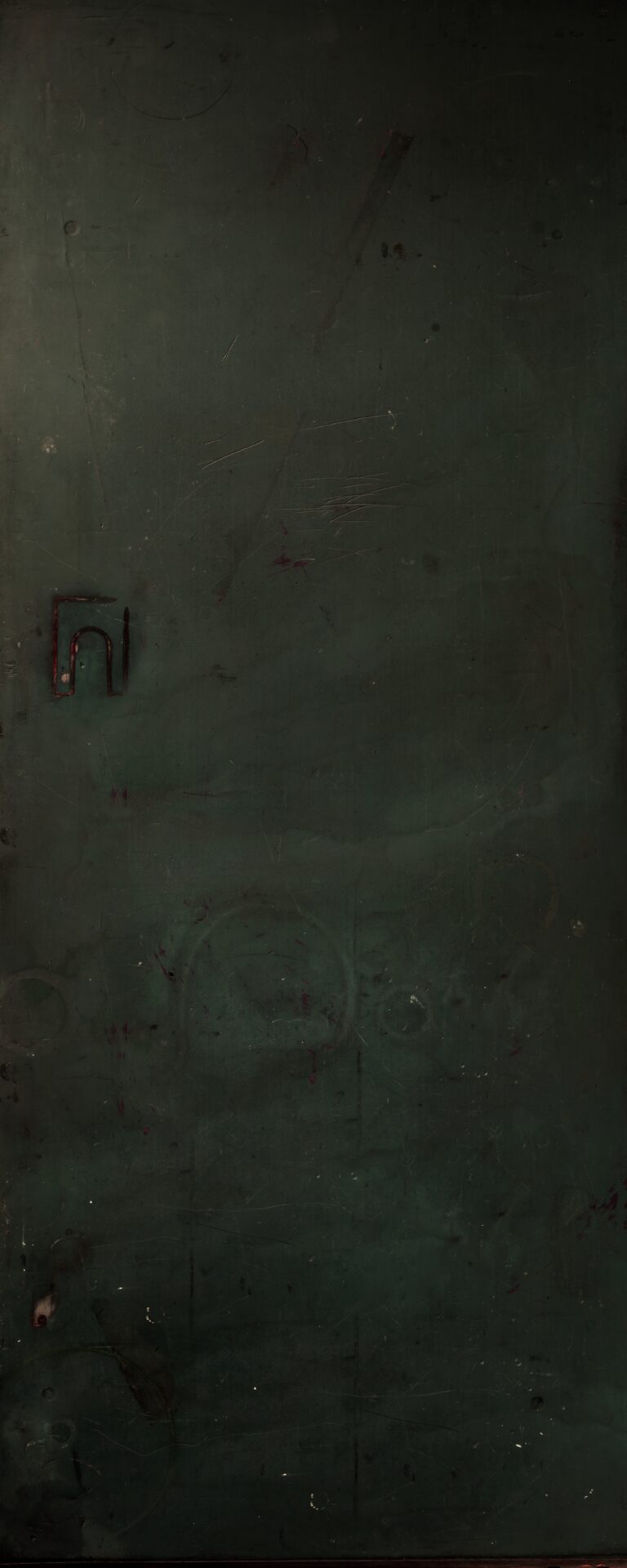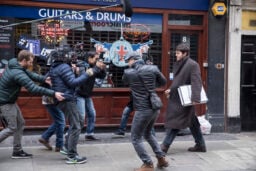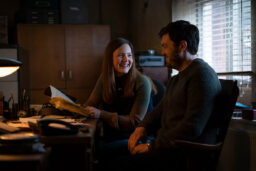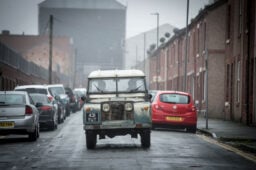The History of Denmark Street
The Agency, and Robin and Strike, have changed a lot since Robin arrived for her first day, but their base remains a two roomed office on the second floor of a house in Denmark Street, a short street with a long history in the centre of London. Denmark Street branches off Charing Cross Road, once famous for its bookshops, just east of Soho and Chinatown – very convenient as Strike now lives above the office and often dines on Singapore noodles.
Denmark Street has been the home to a cast of remarkable characters even before Strike moved in; its history dotted with tragedy and triumphs, so we thought we’d have a closer look at the detectives’ home territory, digging through the archives for some unusual fragments from its past.
Beginnings
The nondescript black-painted doorway of the office she sought stood to the left of the 12 Bar Café; the name of the occupant of the office was written on a scrappy piece of lined paper Sellotaped beside the buzzer for the second floor.
The Cuckoo’s Calling, Robert Galbraith
Denmark Street was built in the 1680s on the grounds of a twelfth century leper colony, and named in honour of Prince George of Denmark, who’d just married into the British Royal Family. It has never been one of London’s most fashionable streets, but is now unique because in spite of centuries of change the original seventeenth century facades survive under the shop fronts you see today. Over the years it’s played host to blacksmiths, cabinet-makers, soap-makers and goldsmiths, travel agents and printers, artists and musicians as well as being a home to business men and labourers. Sometimes inhabitants occupied whole houses, sometimes they were crammed into lodgings far smaller than Strike’s attic flat. Strike is now unusual in making a home there, though new hotels and entertainment venues mean the street remains busy all night.
Night Life
Friday-night revellers were striding and lurching past the end of Denmark Street, umbrellas wobbling, laughter ringing above the traffic.
The Cuckoo’s Calling, Robert Galbraith
Strike and Robin don’t often drink in the office, though Strike does fetch the whisky after accidentally giving his partner a black eye as they investigate the disappearance of Margot Bamborough (Troubled Blood). In the 1920s, though, plenty of revellers could be found in Denmark Street itself. Notorious nightclub owner, Kate Merrick, handed out cards of introduction to the Manhattan Club in Denmark Street, and Pearl Lyndon was fined £180 in 1922 for selling intoxicants at Merry’s Dance Club in Denmark Place. They obviously sold a few too many, as in the same year Marie Scott and Phyllis Bowes were prosecuted for maliciously damaging an oil painting in the club after being asked to leave. We can only hope it wasn’t an oil painting by 18th century master Johan Zoffany, who lived for a time at number nine.
In 1980, the story of illegal drinking in the area took a very dark turn when more than thirty people were killed in an arson attack at the unlicensed Spanish Rooms in Denmark Place. The bar was packed, the fire spread with devastating speed, and fire escapes were chained shut. Some survivors escaped by smashing through into a guitar shop on Denmark Street itself. The man convicted, John Thompson, is still one of Britain’s worst mass murderers.
Music
…windows full of guitars, keyboards and every kind of musical ephemera.
The Cuckoo’s Calling, Robert Galbraith
Though there was a harpsichord maker and a cellist in residence in 1763, it was in the twentieth century that Denmark Street won its reputation as the Tin Pan Alley of Britain. Music Hall songs and other popular hits were published here from 1911, and from then on it became the haunt of dozens of professional and aspiring musicians, with recording studios, venues and publishers all sharing the short street. Taste making magazine Melody Maker was founded here in 1926; The Kinks recorded You Really Got Me in a basement studio and David Bowie, Elton John and Jimi Hendrix used to hang out at the Gioconda cafe. A Blue Plaque marks the spot. Paul Simon tried his luck here too, though the publisher he visited turned down ‘The Sound of Silence’ as ‘uncommercial’. At least one guitar shops survives there today, and Strike shares smoke breaks occasionally with one of the girls who works there.
Damage
She’d barely slammed the door on the outer office when there was a deafening boom and the door blew inwards, cracking in two.
The Ink Black Heart, Robert Galbraith
Pat’s quick thinking saves her and Strike from a parcel bomb as they investigate the death of artist Edie Ledwell, and though the ceiling comes down, no permanent damage to the street is done. It avoided bomb damage during World War II, though Stacey Street round the corner was not so lucky. Denmark Street had another, earlier, escape during the Bloomsbury Gas Explosion of 1928 which tore up surrounding roads, caused car wrecks, and sent flames licking up the side of the houses at the end of Denmark Street.
Change
‘What?’ said Robin, as she emerged into the blustery rain and controlled chaos of the intersection of Tottenham Court Road and Charing Cross Road, at which there had now been building works for three and a half years.
Troubled Blood, Robert Galbraith
Robin and Strike have to deal with the constant building works as the area is transformed by the arrival of the Elizabeth Line at their nearest tube station, Tottenham Court Road, and the huge building projects on the surrounding streets. Even though Denmark Street has survived since the seventeenth century, the city around it has always been in a state of transformation. A century after the street was built, it was surrounded by the rookeries of St Giles, an area of slums notorious for harbouring abject poverty, sundry criminals, and a terrible cholera outbreak in 1848. The slum clearances left Denmark Street unchanged, but around it the city has been repeatedly reimagined, with Centre Point appearing in the 1960s and the rise of the multi-coloured offices and apartments of Central St Giles in the 2000s. Strike’s favourite pub, the Tottenham, opposite the Dominion Theatre, has been renamed the Flying Horse, though its gaudy wall paintings remain. The golden statue of Freddie Mercury which Strike thinks looks like a pagan God of chaos outside the theatre has gone, and all around the huge works of construction and destruction continue.
Mystery
‘Eric Wardle,’ he said in a low voice, with what Strike felt was an unnecessarily charming smile. ‘And this is Detective Sergeant Ekwensi.’
Career of Evil, Robert Galbraith
Strike and Robin’s investigations have drawn detectives and villains to Denmark Street on a number of occasions such as when Wardle and Ekwensi arrive after Robin is targeted with the delivery of a severed human leg (Career of Evil). Rival detective, Mitch Patterson, has also sent an operative disguised as a busker to spy on them in Denmark Street (Lethal White), and Lula Landry’s killer was arrested in the office itself after attacking Strike (The Cuckoo’s Calling). The street is no stranger to crime. Mr Fraser’s shop was relieved of 1400 billiard balls worth £500 in 1903, Patricia King was robbed and left gagged in a basement in 1922; Mary Crawford was fined for allowing her house to be used for improper purposes in 1921 and in 1900, tragically, Charles Mills killed his own illegitimate baby by throwing him in the Thames after taking him from his mother while she was living on Denmark Street with her parents. The street has been visited by detectives in the past too, sometimes solving unusual mysteries. Townsend and Jealous, ‘very meritorious officers’ of Bow Street arrested an apprentice watch-maker here in 1794 for his part in a plot to assassinate the King George III (who Zoffany painted) with a poisoned dart.
With Robin Ellacott and Cormoran Strike in residence, we can guarantee that Denmark Street will continue to offer up dark histories and strange mysteries into a creative, challenging and ever-changing city and behind its ancient facades, new stories are taking shape.




